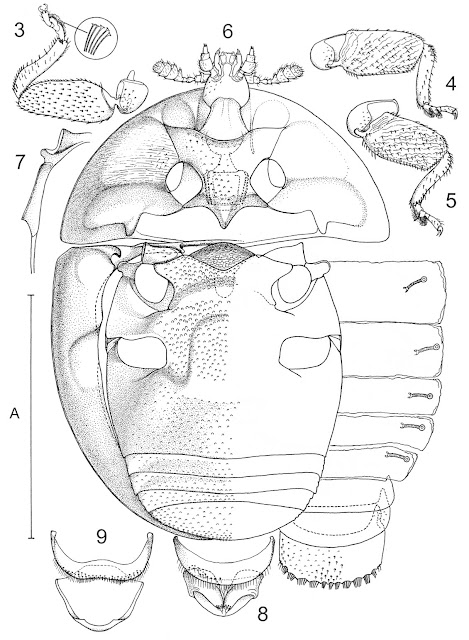Despite the prevalence of photography in scientific and technical books and papers today, there are still times when a scientific work will call for a more traditional approach. Drawing remains an important part of natural history illustration, and can often provide a more specific and flexible way of communicating information.
 | |
| An example of the way key features can be highlighted and isolated to provide clarity in a drawn illustration. Cleidostethus meliponae Arrow, from the genus Cleidostethus Arrow, by Stanley Bowestead. |
Stanley Bowestead and Thomas Eccles are both enthusiastic
advocates of drawing and have recently published a joint paper on technical
drawing for publication in collaboration with the HEC. They argue
that the value of drawing lies not only in the end results ability to communicate,
but also that the process of drawing is in itself crucial to the better
understanding of the subject at hand. Producing
a detailed drawing of a beetle for example, requires rigorous observational skills
and after studying the insect, the observer will have gained a unique
understanding of the form of that specimen.
 |
|
Anatis ocellata (L.) by
Stanley Bowestead. White gel pen has been used to highlight the setae on the legs.
|
In the past it was not only the lack of modern
alternatives which made drawing a popular tool for documenting scientific
findings. Science, art and religion all used
to be closely linked to one another - to the point of being virtually indistinguishable
as separate subjects. The study and
appreciation of natural history through drawing was thought to bring a person
closer to God, as well as being at the height of fashion during the Victorian
era.
So, it is shifting attitudes towards science and
art, as well as photographic advances and the development of other imaging
techniques such as SEMs, that have lead drawing to decline over the last 50 years or so in the study of natural history.
Stan and Thomas’ paper as well as being a practical
how to guide on the technical drawing of insects, hopes to promote the value of
drawing alongside other contemporary methods of illustration, as being
something which remains relevant and
invaluable as a learning resource in the field of science today.
 |
|
Lebia chlorocephala
by Thomas Eccles. Worked in colour pencil with highlights picked out in white ink.
|
The paper is available to download for free from the museum’s website.


thank you for the detailed drawing, really helpful.
ReplyDeleteHi there, awesome site. I thought the topics you posted on were very interesting. I tried to add your RSS to my feed reader and it a few. take a look at it,
ReplyDeletehopefully I can add you and follow.
Estimation Techniques Training
The drawing techniques for publication are an invaluable asset. The comprehensive guidance and practical insights offered are exceptionally helpful How Protect Business for artists aiming to enhance their art.
ReplyDeleteThe drawing techniques for publication are highly beneficial. The detailed instructions and valuable insights provided are a boon for artists looking to improve their work for print. Good Travel Apps Mastering these techniques opens up new possibilities for creating captivating visuals.
ReplyDelete